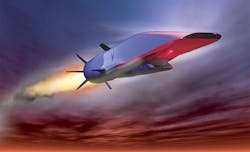Boeing Joins DoD’s Hypersonics R&D Efforts
Boeing is initiating two development projects to advance hypersonic weapons capabilities, in coordination with the U.S. Dept. of Defense and the LIFT manufacturing research institute. The two projects represent a new phase in the Hypersonics Challenge program launched last year by LIFT and DoD, along with Lockheed Martin Corp. to field proposals for projects critical to the materials science and manufacturing processes of hypersonic vehicles.
LIFT is the Detroit-based the Lightweight Innovations for Tomorrow program, a research center established in 2014 to coordinate academic and industrial research into lightweight mobility technologies. It is operated by the American Lightweight Materials Manufacturing Innovation Institute, and partly funded by the Dept. of Defense and managed through the Office of Naval Research.
Hypersonic weapons are high-speed (Mach 5 or above) missiles that travel at suborbital heights, making them difficult for air-defense systems to track and intercept due to their speed and maneuverability. Hypersonic capabilities have been named a top developmental priority for the U.S. Dept. of Defense, amid evidence of China’s successful tests of hypersonic weapons this year.
Boeing’s first project – in partnership with Powdermet Inc. – seeks to demonstrate near-net-shape manufacturing of metal-matrix composite components for hypersonic vehicle demonstrators. The goal will be “high-performance, high-temperature alloys” that can increase effectiveness of components during hypersonic flight, and that when used in near-net-shape manufacturing will deliver mission-critical components that are “durable, reliable and rapidly manufacturable.”
The second Boeing project – with partners RPM Innovations Inc. and Intelligent Optical Systems Inc. – aims to develop and verify a suite of in-situ build process monitoring sensors and non-destructive evaluation (NDE) approaches applicable to laser-directed energy deposition (L-DED) manufacturing, for hypersonic applications. The current, post-process quality verification method is time-consuming and expensive. The goal is an in-process monitoring technique that will help inform the quality of the build during the process, saving time and expensive metal powders.
“These projects will benefit the entire American manufacturing base, helping spur technology development from material producers all the way up to original equipment manufacturers (OEMs),” stated Boeing Research & Technology metallurgist/materials engineer Austin Mann.
An earlier Hypersonics Challenge project, announced in December 2021, involves LIFT member companies Velo3D Inc. and Vibrant Corp., and the University of Arizona, evaluating laser powder-bed fusion additive manufacturing, rapid post-build non-destructive inspection, and defect detection for flight-qualified hypersonic metallic structural applications.
Also, LIFT awarded a research project to ATC Materials Inc., The Ohio State University, and the University of Dayton, to demonstrate reliable production of RIPS molded radio-frequency (RF) material. As-molded and molded-machined components will be manufactured and tested, to determine the validity of net-shape molding of the material that is eyed for hypersonic sensors and seekers.
